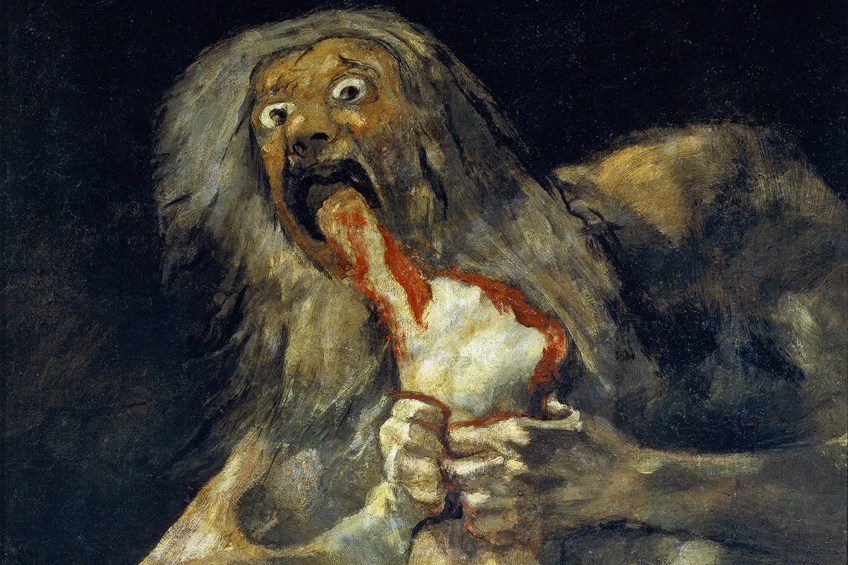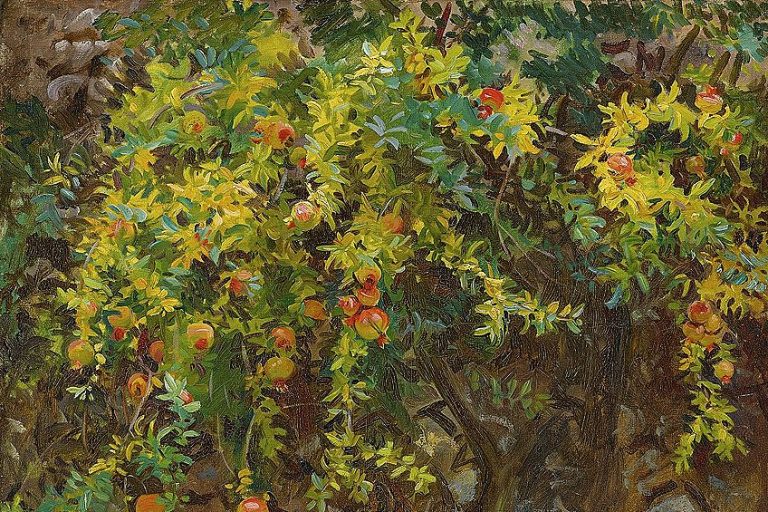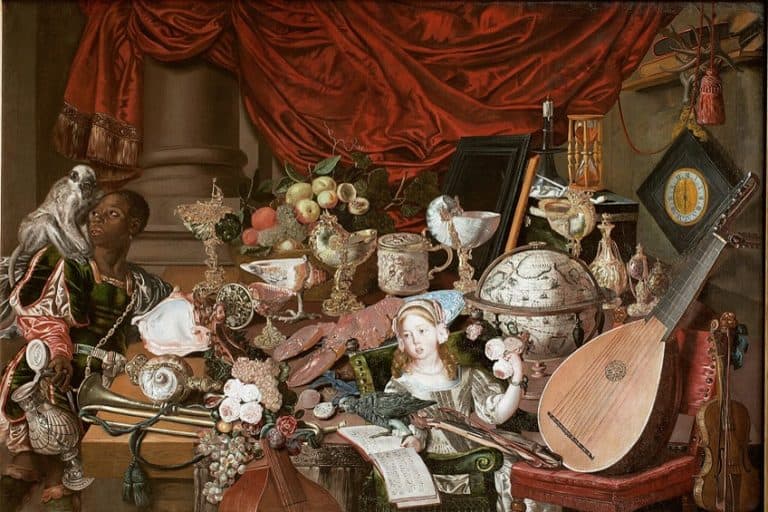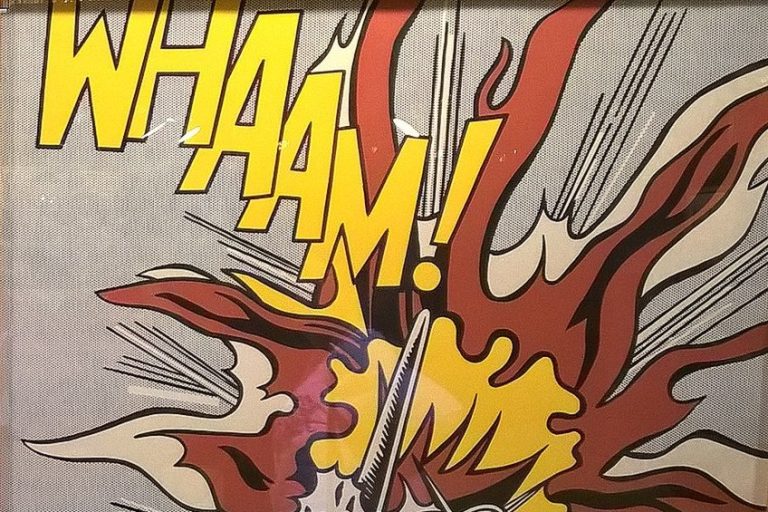Francisco Goya “Black Paintings” – Examining Goya’s Dark Paintings
In this article, we look at the Spanish artist Francisco Goya’s Black Paintings, which he painted as murals in his villa, the “Quinta del Sordo”, around 1819 to 1823. These are not your average wall paintings, however; they are dark and somewhat scary at times, but let us take a closer look.
Table of Contents
Artist Abstract: Who Was Francisco Goya?
Francisco José de Goya y Lucientes lived during the 1700s and 1800s. He was born on March 30, 1746, and died on April 16, 1828. He was born in Spain in a town called Fuendetodos. When he was around 14 years old, he studied under José Luzán for several years, as well as Anton Raphael Mengs and Francisco Bayeu, whose sister he married.
He was a painter for the Royal Court and figures of Spanish nobility.
The war between France and Spain impacted Goya and he painted the famous artworks The Second of May, 1808 (1814) and The Third of May, 1808 (1814), among others. In his later years, around the 1810s, he became more reclusive due to his deafness.

Goya’s art style has been described as Romantic and he explored topics that were rooted in socio-political challenges. Some of his work has also been regarded as quite dark in nature, but nonetheless, Goya was a forefather of modern art because of his more expressive artistic style.
He is repeatedly described in the art world as “the last of the Old Masters and the first of the moderns”.

Black Paintings (c. 1819-1823) by Francisco Goya in Context
Francisco Goya’s Black Paintings from around 1819 to 1823 were among some of this Spanish artist’s darkest paintings. In the brief contextual analysis below, we will discuss when and where Goya painted these, what they are, and what the conditions of his life were like when he painted them.
We will then look at a formal analysis, discussing one of these 14 paintings, namely, Saturn Devouring His Son (1821-1823), in more detail. We will look at the subject matter as well as Goya’s artistic style in terms of art elements like color, texture, form, and others.
| Artist | Francisco Goya |
| Date Painted | c. 1821-1823 |
| Medium | Mural painting with mixed media, transferred to canvas |
| Genre | History/Mythological painting |
| Period / Movement | Romanticism |
| Dimensions | 143.5 x 81.4 centimeters |
| Series / Versions | Part of Goya’s Black Paintings |
| Where Is It Housed? | Museo Nacional del Prado, Madrid, Spain |
| What It Is Worth | Given to the Museo Nacional del Prado after Baron Frédéric Émile d’Erlanger donated it to the State of Spain. |
Contextual Analysis: A Brief Socio-Historical Overview
The Spanish artist Francisco Goya bought a new home in 1819 just outside of Madrid. It was a country house, or villa, called Quinta del Sordo, which roughly translates to “House Of the Deaf Man” in Spanish. Goya was around 73 years old at the time and suffered from deafness due to an illness he contracted around 1792/1793. However, the house was not named after him, but after the previous owner who was also deaf.

It was during the same time that Goya painted what is referred to as his Black Paintings, which he approximately started around 1819 or possibly 1820. Reportedly Goya did not name his dark paintings and they were titled only years later. In 1828, the Spanish artist Antonio Brugada created a catalog of the paintings.
Goya reportedly painted 14 compositions on the walls of his two-story house; some paintings were on the ground floor, and some were on the upper or first floor.

The names given below are of Francisco Goya’s Black Paintings in alphabetical order. It is important to note that the dates range from 1819/1820 to 1823, with the exception of Saturn Devouring His Son, which has been given the date range of between 1820 to 1823.
- Atropos (The Fates)
- Fantastic Vision
- Fight with Cudgels
- Judith and Holofernes
- La Leocadia
- Men Reading
- Procession of the Holy Office
- A Pilgrimage to San Isidro
- Saturn Devouring His Son
- The Dog
- Two Old Men
- Two Old Ones Eating Soup
- Witches’ Sabbath
- Women Laughing
It has been suggested that Goya did not intend for these Black Paintings to be shown to the outside world through exhibitions or any other form of display, nor was he sponsored or commissioned. The widely accepted consensus is that he painted them in the privacy of his own home.
The Curious Case of Goya’s Black Paintings
There is, however, another theory about Goya’s Black Paintings that has sparked some speculation in the art world. Some scholars believe that Goya was not the original artist of the Black Paintings. Two notable scholars have been widely referred to, namely Juan José Junquera and Nigel Glendinning.
Junquera postulated that Goya’s son Javier Goya was the artist behind the “Black Paintings”.
This was believed to be a possibility due to evidence of documents that showed Quinta del Sordo had one floor when Goya lived there. Reportedly, the upper floor was only built after Goya lived there after he died. Furthermore, it was postulated that Mariano Goya, the grandson of the artist, said the paintings were by Goya himself. This was believed to be the case because Mariano was looking for more money when he sold Quinta del Sordo, which he inherited from Goya, which would have inevitably given the villa a better reputation.

Nigel Glendinning argued against the above theory, stating that the documents about the villa were unclear about the validity of the two stories. Furthermore, he has also been quoted as questioning the validity of Javier as a painter, and almost no accounts of signed paintings by him.
It is also important to note that while the above-mentioned theories have been extensively debated, we have only provided a brief outline of them. There is a depth of research related to this and we encourage you to delve deeper into it and learn what other scholars have suggested.
The Meaning of Goya’s Dark Paintings
Francisco Goya’s Black Paintings has been named thus not only because they are visually dark, predominantly painted in blacks, browns, and grays, with additional hues like whites, reds, and blues, but also because of their dark underlying psychological aspects. Goya painted a wide range of subject matter in his Black Paintings, ranging from female and male figures to animals like the dogs and the large black goat in Witches’ Sabbath.
All the above acted out different religious and mythological narratives with themes like death, aging, conflict, evil, and witchcraft.
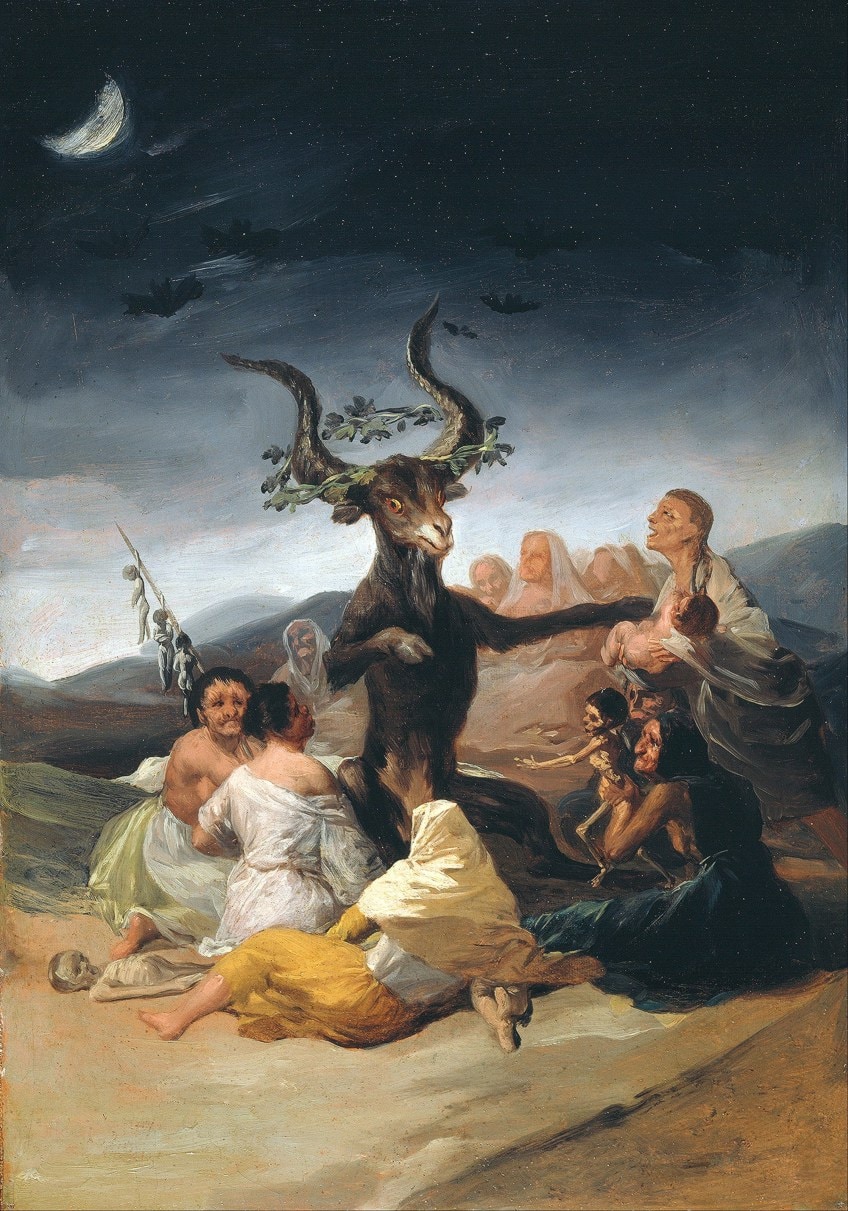
Furthermore, we will also see heightened emotional states like anguish, loneliness, gloom, and some smiles, and laughter here and there, but even these appear hair-raising at times. These paintings have also been described as “satirical”.
The questions have inevitably been raised around why Goya created these dark paintings compared to his previous paintings, which are evidently two different artistic styles.
Some scholars suggest it was because of his own deteriorating mental faculties, his trauma related to his illnesses, and the harrowing experiences from the wars between France as well as Spain’s own internal conflicts.
Formal Analysis: A Brief Compositional Overview
In the formal analysis we will take a closer look at one of Goya’s most famous Black Paintings titled Saturn Devouring His Son, which was reportedly on the lower/ground floor of the villa. Additionally, we will mention other paintings from this collection to provide a wider context. This will be followed by a look at a few of Goya’s artistic techniques like the way he utilized color, texture, form, and space.
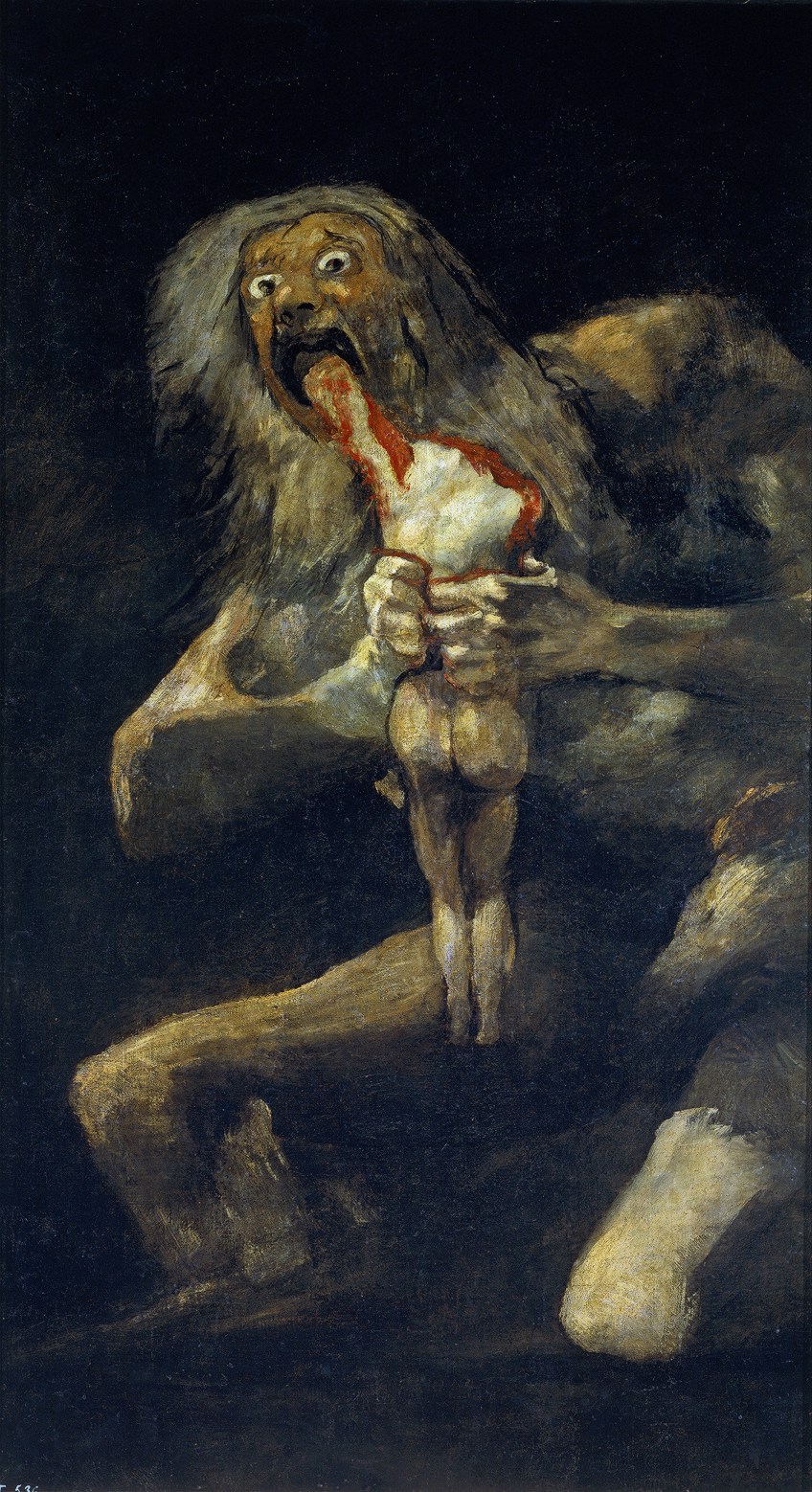
Visual Description: Subject Matter
Saturn Devouring His Son depicts the Roman god known as Saturn in the process of cannibalizing his son. For a clearer understanding, Saturn was the god of agriculture and time, among other traits. He was originally a Greek Titan, called Cronos.
According to a prophecy, he was going to be overthrown by one of his children, and as a result, he decided to eat all his children to avoid his fate.
Saturn is depicted as a large, almost bony figure. He appears to be sitting on one knee, and his left knee (our right) rests on the ground. He is clasping the dead body of one of his children in both hands. It is evident he is holding the body tightly as there is blood between his fingers and his knuckles are prominent.

The body is lifeless in Saturn’s grip, furthermore, it is headless and missing its right arm, suggesting that he already devoured those body parts. Its left arm is outstretched and almost inside Saturn’s mouth, it appears as if the hand has already been bitten off. In scholar John J. Ciofalo’s publication The Self-Portraits of Francisco Goya (2001), he suggested that the child is female because of the “curvaceous buttocks and legs”.
Furthermore, it looks like the figure is an adult and not an infant, as many other renditions of the myth illustrate.

The devouring god’s mouth is agape as he gets ready to chew off the next part of the arm and his eyes are bulging and wild in their gaze. Similarly, his gray hair, which flows just below his shoulders, is also wild in appearance.

It is unclear where Saturn is sitting, or hunching, as the surrounding environment appears dark. He could possibly be on the ground, undoubtedly somewhere hidden and dingy. Additionally, many sources have also described an “engorged” phallus between the god’s legs as he is in the process of devouring his child, which heightens the emotional intensity and rawness of the image.
The Symbolism and Influence of Saturn Devouring His Son
This image is dark and strikingly macabre in its portrayal. It touches on primal and beast-like aspects of nature, and to go one step further, possibly human nature. We could also raise the question: If Goya painted this without the intention of it being seen by others, and ultimately evoking contemplation within them, was it merely a cathartic expression of the artist’s inner musings and thoughts about his life and the events that took place around him? Was it a metaphor for the devouring nature of life in all its facets and death in all its gore?
Goya lived through some challenging and horrific experiences, which ultimately impacted his psyche.
We do not know exactly what message he intended for this painting, but there have been many suggested interpretations and it can be viewed allegorically, as a possible symbol of the darkness he experienced and witnessed.
In Jay Scott Morgan’s scholarly journal article titled The Mystery of Goya’s Saturn in the New England Review (Volume 22, Number 3, summer 2001), several ideas are suggested. For example, Goya could have been influenced by the traumatic effects of his wife’s, Josefa Bayeu, miscarriages a few years prior.
Reportedly, the couple had eight children, of whom seven died, not only through a miscarriage but also in childhood. Javier was the only child that survived into adulthood. Maybe the figure of Saturn and the story that surrounds his myth was a symbol for the loss of Goya’s own children’s lives?
Morgan also wrote about Saturn through the lens of the god of Time, bringing up ideas of mortality and death, also pointing to Goya’s own human nature, especially after his illnesses.
Furthermore, Goya could have also depicted him as a symbol of war, as Morgan suggested, as a possible “sardonic commentary on Spain’s recent war with France”, asking if Saturn is “forced to overfeed on the numberless dead” – again playing on the idea of time and mortality – also questioning if this Saturn was a “culminating portrait of the horrors” from Goya’s series of 82 etchings titled Disasters of War, which he made between 1810 and 1820.

Various sources also suggest that Goya was possibly influenced by the Baroque and Flemish painter Peter Paul Rubens and his oil on canvas Saturn Devouring a Son (1636-1638); the child in Rubens’ rendition of the Greek/Roman myth is an infant. This painting is housed in the Museo del Prado in Madrid.
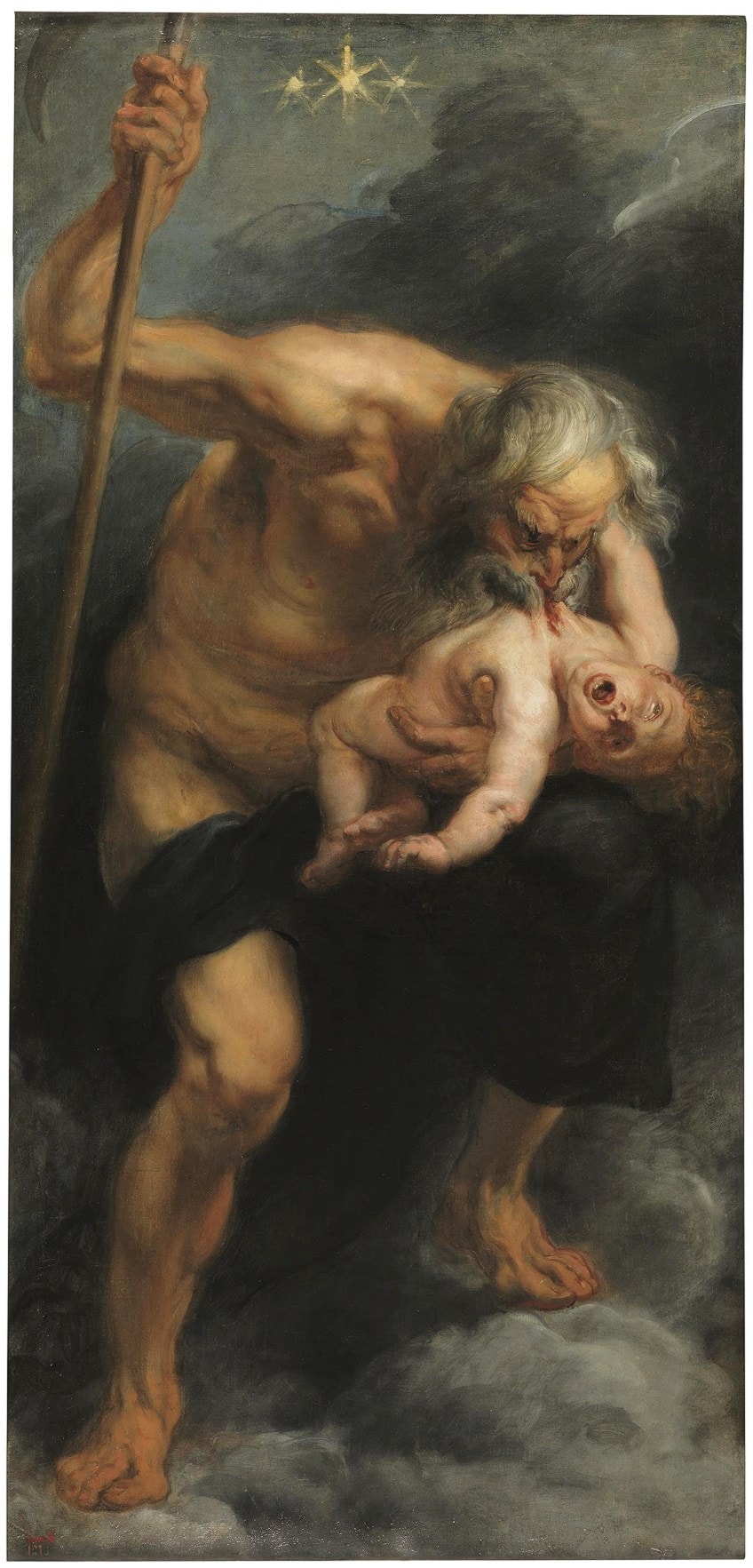
Around 1796 and 1797, Goya also produced a drawing in chalk of this scene, depicting Saturn devouring a child’s leg while holding onto the body of another child in his left hand (our right). The children in this drawing also appear adult and not infantile as we see from Rubens’ painting.
It can be questioned that Goya had this idea before his “Black Paintings”, which would give us more context as to what motivated him to paint it as a mural.

Color and Value
Goya utilized a dark color scheme in Saturn Devouring His Son and reportedly painted in different media including oil paint. In this mural, we see mainly blacks, grays, and browns on the two figures, which stand out against the contrasting blackened background.
There are also hints of red for blood.

There are lighter tinted areas of paint prominent on the upper back and calves of the dead body and Saturn’s right (our left) wrist and his left knee (our right). However, we also see these lighter areas on other parts of his body. There are also darker shaded areas, all of which create emphasis on the figure’s skin tone, creating more definition. These areas could also suggest an unknown light source.
Notice how Goya’s use of paint and techniques interplay with and inform his subject matter.
The neutral colors and their chosen hues create a ghastly effect for the figures, which ultimately adds to the somber mood and emotional impact of the subject, which in this case is Saturn in the process of eating his child.

Texture
Goya appeared to have painted in an expressive manner with loose brushstrokes often thickly applied, referred to as impasto. If we look closely at the composition, we will notice the physical texture of the paint made from the brushstrokes. These are also visible as the outlines of the contours of the bodies.
This almost wild use of brushstrokes and texture corresponds to the wild nature of the subject, and we recall this in Saturn’s wide and wild eyes.
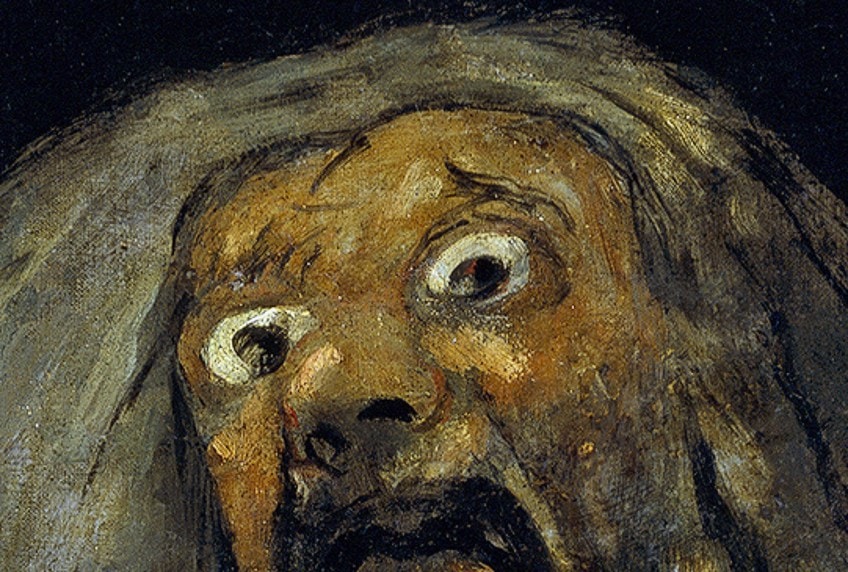
Line, Form, and Shape
In Saturn Devouring His Son, linearity is defined by the almost bony figure of Saturn. The position of his legs and arms, which appear almost perpendicular to his legs, create a diagonal emphasis, which is countered by the vertical placement of the dead body in Saturn’s grip.
There is a similar wildness of form in this rendition, as Saturn’s body appears misshapen in areas, for example, the lower part of his right leg (our left) and the unknown shape between his legs, which juts outwards over his left hip bone area (our right). This could also refer to the phallic symbols mentioned above.
Saturn is depicted almost as a grotesque animalistic human, and his shape is somewhat organic and figurative. In other words, we can understand what we see when we view him as he is not wholly abstracted to the point of non-recognition.
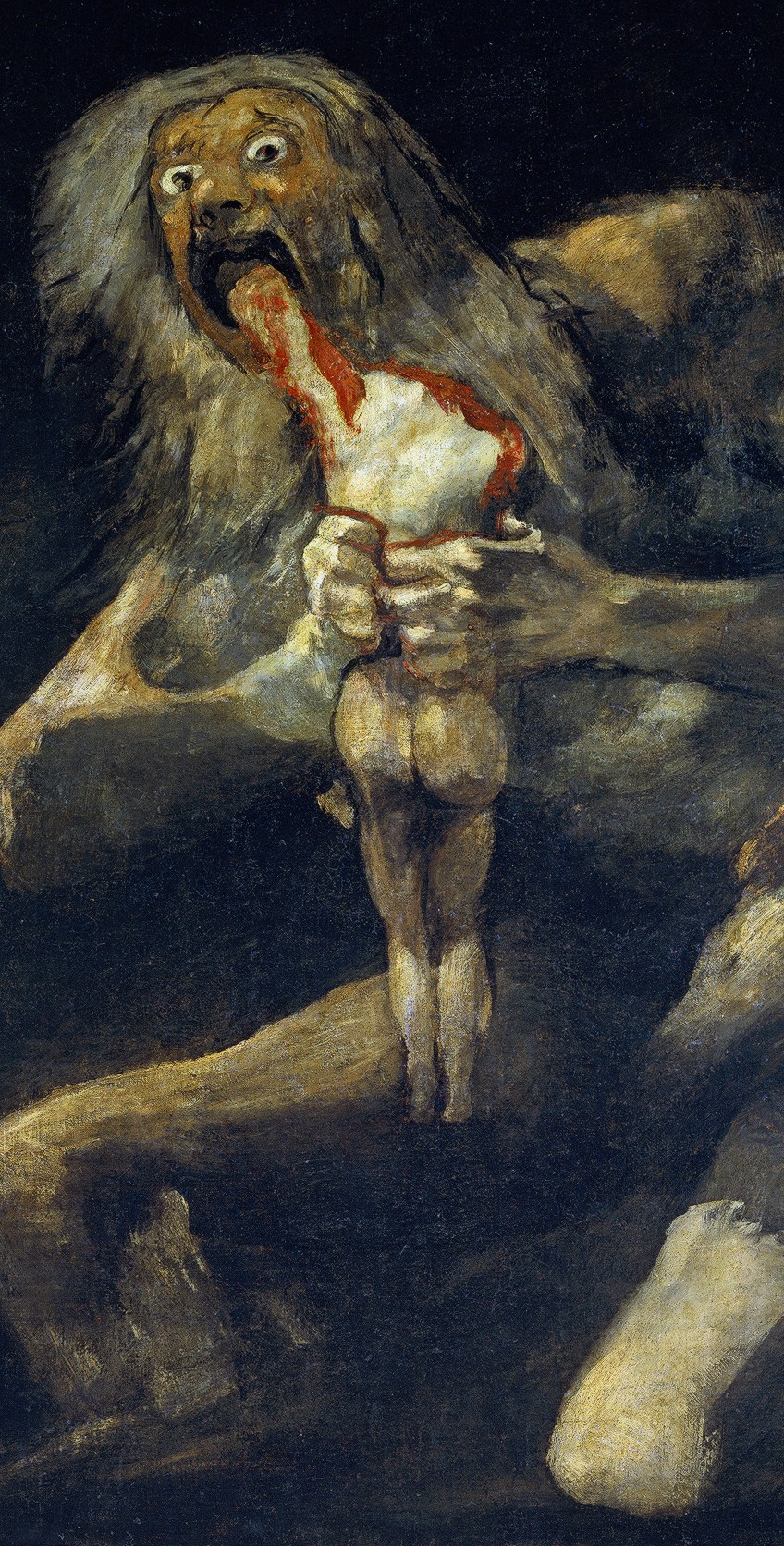
Space and Perspective
Saturn’s giant-like stature fills the space from the right-hand side of the composition. However, his figure is partially cut off and we are not able to see him in full. This could possibly create a dramatic effect as we are engulfed by this figure entering the space and not quite filling it either.
We can only imagine what this painting looked like in its original position on the walls of Quinta del Sordo, measuring around 143.5 x 81.4 centimeters.
It is interesting to note that in many of the other artworks from the Black Paintings the subject matter is also positioned from various perspectives. For example, in The Dog, we see a large expanse of negative space in the top two-thirds of the painting, and the dog, which is the positive space, is in the lower third, looking up at an unknown source.
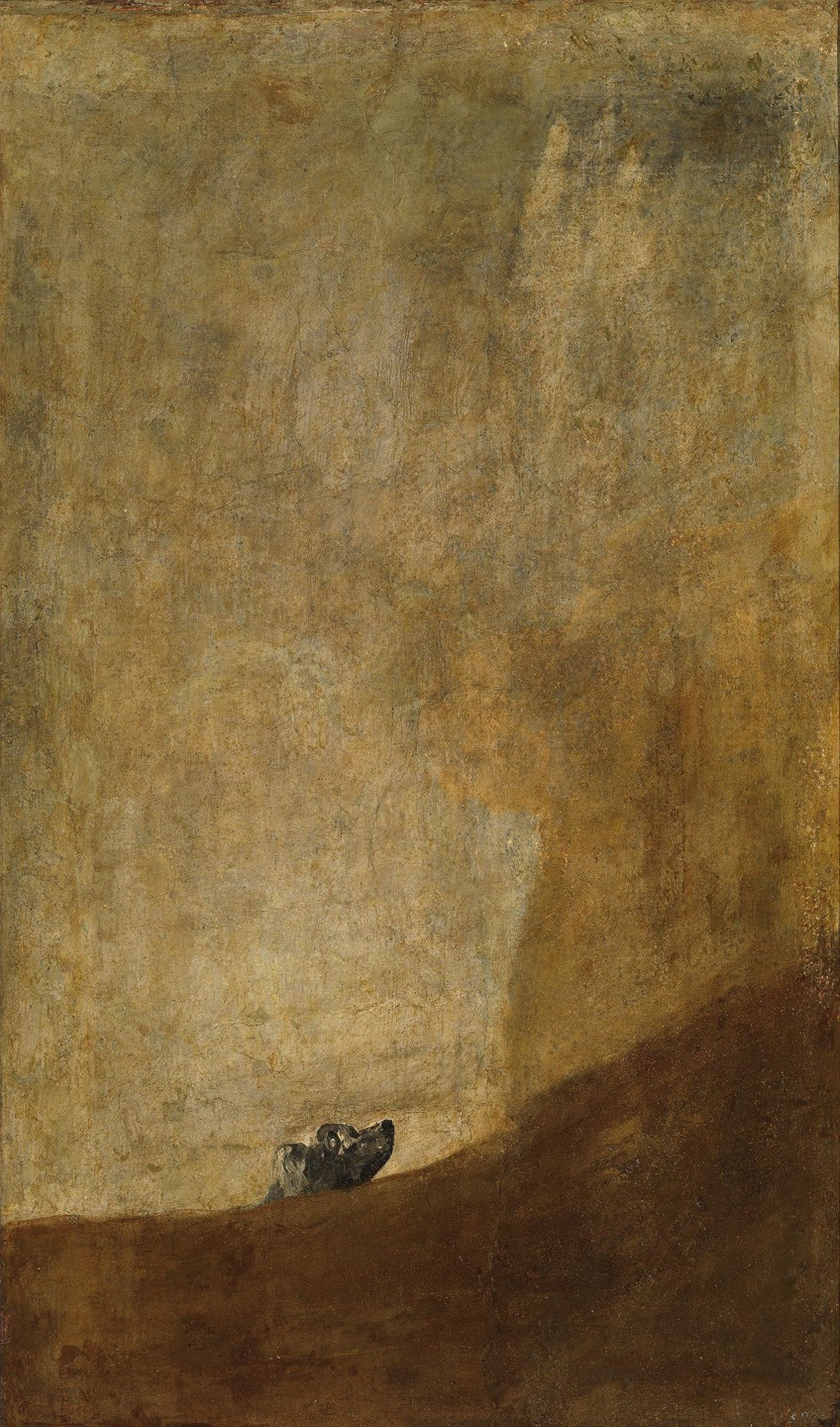
Similarly, in Fight with Cudgels, we see two figures in the throes of a cudgel, or club, fight. They are positioned slightly to the left of the composition leaving an open space on the right-hand side depicting a hill in the distant landscape.

We also see this positioning of figures in Procession of the Holy Office, which depicts a procession of people coming into the forefront of the composition from the background all the way to the bottom right corner, almost in our space. In Fantastic Vision and Atropos (The Fates), Goya again placed the focal points, which are groups of figures floating in mid-air, on either side of the composition.

Goya Leaves Us Aghast
In nearly all of the 14 Black Paintings series by Francisco Goya we see depictions of people who are either deeply terrifying, in contemplative or jovial moods. Goya gave us a spectrum of emotions and, whether portrayed through myth or any other narrative, he painted aspects of human nature and ultimately that which could spring forth from the depths of the human psyche.
Goya’s dark paintings are wells of meaning and it is a well-known fact that some art historians and scholars have been able to decipher some of these paintings, while others have been left in the dark.
Furthermore, the paintings we see now are housed in the Museo del Prado, taken from their original spots on the walls of Goya’s previous villa, which he left in 1824 to move to Bordeaux in France. Years later, after the paintings were removed from the walls of the Quinta del Sordo in 1875, Spain took part in the 1878 retrospective art exhibition in Paris at the Exposition Universelle, located at the Trocadero Palace. The Spanish section boasted several of the Black Paintings by Goya.

Despite the “Black Paintings” series being damaged as a result of its relocation, we have since been given the opportunity to view the interior of Goya’s home. Whatever he meant, or did not mean, by his paintings, he nonetheless left a lasting impression on the art world, notably influencing art movements like Expressionism and Surrealism.
Frequently Asked Questions
Who Painted the Black Paintings?
The Spanish artist Francisco Goya painted what has been called his Black Paintings on the walls of his villa, Quinta del Sordo, outside of Madrid. These were believed to have been started around 1819/1820 to 1823.
How Many of Goya’s Black Paintings Are There?
Francisco Goya’s Black Paintings consisted of reportedly 14 paintings. However, some scholars have also noted that there could have been a 15th painting titled Heads in a Landscape (c. 1820-1823). This painting is part of the Stanley Moss collection.
What Happened to Francisco Goya’s Black Paintings?
In 1874, Francisco Goya’s Black Paintings were removed from the walls and each placed on a canvas. After Baron Frédéric Émile d’Erlanger donated the paintings to Spain in 1881, they were eventually housed at the Museo Nacional del Prado in Madrid, where they are at present.
Alicia du Plessis is a multidisciplinary writer. She completed her Bachelor of Arts degree, majoring in Art History and Classical Civilization, as well as two Honors, namely, in Art History and Education and Development, at the University of KwaZulu-Natal, South Africa. For her main Honors project in Art History, she explored perceptions of the San Bushmen’s identity and the concept of the “Other”. She has also looked at the use of photography in art and how it has been used to portray people’s lives.
Alicia’s other areas of interest in Art History include the process of writing about Art History and how to analyze paintings. Some of her favorite art movements include Impressionism and German Expressionism. She is yet to complete her Masters in Art History (she would like to do this abroad in Europe) having given it some time to first develop more professional experience with the interest to one day lecture it too.
Alicia has been working for artincontext.com since 2021 as an author and art history expert. She has specialized in painting analysis and is covering most of our painting analysis.
Learn more about Alicia du Plessis and the Art in Context Team.
Cite this Article
Alicia, du Plessis, “Francisco Goya “Black Paintings” – Examining Goya’s Dark Paintings.” Art in Context. June 15, 2022. URL: https://artincontext.org/francisco-goya-black-paintings/
du Plessis, A. (2022, 15 June). Francisco Goya “Black Paintings” – Examining Goya’s Dark Paintings. Art in Context. https://artincontext.org/francisco-goya-black-paintings/
du Plessis, Alicia. “Francisco Goya “Black Paintings” – Examining Goya’s Dark Paintings.” Art in Context, June 15, 2022. https://artincontext.org/francisco-goya-black-paintings/.


